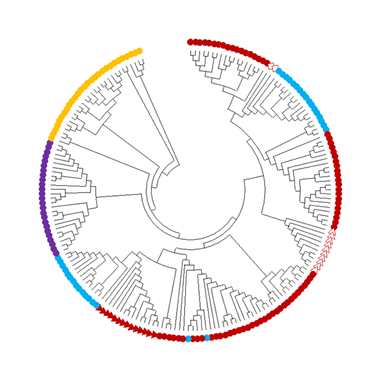This week, February 12, we celebrated the birthday of Sir Charles Darwin, one of the most influential figures in the history of science, who was born in 1809. His book 'The Origin of Species', published in 1859, presented a revolutionary answer to one of the basic questions that have occupied naturalists for centuries: How do new species form in nature?
By Shahar Labid and Prof. Binyamin Podbilevitz, Faculty of Biology, Technion

Darwin was the first to present a dynamic mechanism that provides a consistent explanation for the formation of new species - the principle of natural selection, which drives gradual evolution [1]. This new concept includes several aspects: struggle for survival, that is - the presence of external pressure that affects the survival of individuals; The presence of diversity in the population, and the hereditary transmission of traits that give a certain ability to deal with these pressures (fitness) [2].
Over a decade later, Darwin published a slightly less well-known book in which he delved into the subject of mate selection as a distinct form of natural selection [3]. Darwin formulated his distinction mainly for male individuals who have an advantage in mating. These individuals would pass this advantage on to their male offspring, Darwin said, regardless of other survival pressures. This term of mate choice has since been extended to all the aspects involved in the mating process, at all levels of biology, from the behavioral to the molecular [4].

During fertilization itself, the interaction between gametes, such as sperm and egg, may be the decisive step in the success of the reproductive process. Specifically, the step of fusing the gametes together is not spontaneous and requires the proper activity of special fusion proteins called 'fusogens'. In the last decades many phosogens have been discovered, some of them are related to sexual reproduction while others are involved in the fusion of somatic cells (which are not sex cells) [5]. Furthermore, it is possible to group a large part of these proteins, based on structural similarity, under one family called fusexins (Figure 1). Interestingly, despite the structural similarity, the proteins in this family belong to a huge variety of species including viruses, plants and single-celled organisms; Some of them play a role in viral infection, some in gamete fusion and some are somatic [6]. This widespread distribution in different systems naturally raises the question of their evolutionary origin [7].
Recently, another branch was added to the fusexins family, with the discovery of proteins with a similar structure and function in archaea [7]. This discovery may imply a common ancestor for many of the eukaryotic fusion proteins and those originating from archaea, but there is another possibility in which these proteins were used for viral infection and allowed the transfer of genes between species without gradualness ("Horizontal gene transfer") [7]. It is possible, therefore, that fusion proteins from archaea were transferred through viruses to eukaryotes, where they evolved in some species to play a role in gamete fusion [7].
These findings and many others continue Darwin's way of discovering the different stages of evolutionary development. From the origin of sexual reproduction and the early development of eukaryotic species to the processes that govern entire ecosystems, the theory of evolution continues to provide a framework through which scientists study developmental processes, looking to the past as well as to the future.
Sources:
[1] Darwin CR (1859). On the Origin of Species. p.61.
[2] Griesemer J. (2001). The Units of Evolutionary Transition, Selection, 1(1-3), 67-80. DOI: https://doi.org/10.1556/select.1.2000.1-3.7
[3] Darwin CR (1871). The descent of man, and selection in relation to sex. London: John Murray. Volume 1.
[4] Kuijper B., Pen I., Weissing JF (2012) A Guide to Sexual Selection Theory. Annual Review of Ecology, Evolution, and Systematics, Vol. 43:287-311https://doi.org/10.1146/annurev-ecolsys-110411-160245
[5] Avinoam O., Fridman K., Valansi C., Abutbul I., Zeev-Ben-Mordehai T., Maurer UE., Sapir A., Danino D., Grünewald K., White JM., Podbilewicz B. (2011). Conserved eukaryotic fusogens can fuse viral envelopes to cells. Science. Apr 29;332(6029):589-92. doi: 10.1126 / science.1202333
[6] Valansi C., Moi D., Leikina E., Matveev E., Graña M., Chernomordik LV, Romero H., Aguilar PS, & Podbilewicz B. (2017). Arabidopsis HAP2/GCS1 is a gamete fusion protein homologous to somatic and viral fusogens. J Cell Biol, 216 (3), 571-581. https://www.ncbi.nlm.nih.gov/pmc/articles/PMC5350521/
More of the topic in Hayadan:
- The genes that "make man"
- Natural selection - last part of the chapter on Darwin in Mario Livio's book 'Genius Errors'
- Researchers from Tel Aviv University succeeded in transplanting corneas and 'welding' them into place in the eye - using a smart system based on a laser and an optical fiber
- Revolution - another excerpt from the second chapter of Mario Livio's book "Genius Errors"
- Why Southeast Asia?
